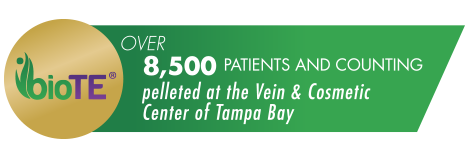Treatment FAQs
-
Why Haven’t I Heard of This Method Before?
Even though pellet therapy has been in use since the 1930’s, many have not heard of the treatment because pellets cannot be patented and marketed by pharmaceutical companies. Companies cannot profit from pellets in the same way they can from other hormones such as Estratest, Premarin, Provera or PremPro.
-
How Does Bio-Identical Pellet Therapy Work?
Pellet therapy has been in use since the 1930s, with a long history of safe, effective results. The pellets are small, about the size of a grain of rice, and comprised of compounded estrogen and testosterone, which are derived from natural plant sources—not synthetics—and designed to get the body back to optimal levels. Once placed under the skin, the pellet implants consistently release small, therapeutic doses of hormones into the bloodstream for approximately four to six months. This helps to provide optimal therapy without the “roller-coaster” effect common with some other hormone replacement methods. Pellet therapy has been shown to outperform all other delivery methods including oral, patch, creams, and injections for consistency and results.
-
Why are Bio-Identical Hormones the Safe Option?
In 2002, the Women’s Health Initiative (WHI) completed a clinical trial on the effects of combination hormone therapy. This study led many people to fear that hormone therapy could cause breast cancer, stroke, and heart disease. Though some invaluable findings resulted from the tests, there were a number of important points that were not made widely known.
First, in the original study, a synthetic progesterone, called Provera, together with an estrogen derived from pregnant horse’s urine, called Premarin, were determined to be the main cause for concern. The combination, which was marketed together as Prempro, resulted in a 24 percent increase in risk for breast cancer and heart disease for the women who took the combined synthetic hormones.
The participants who were under 60 years of age during the trial and took only the estrogen showed no increased risk for either breast cancer or heart disease. In fact, after five years of estrogen-only therapy, the same women showed 61 percent less calcified plaque in the arteries—a common indicator of heart disease—than the women assigned to the placebo.
Secondly, it’s important to note, bio-identical hormones were not utilized in any of these clinical trials. No published study to date has indicated an increased risk between breast cancer or heart disease and bio-identical progesterone. On the contrary, studies have shown the opposite, with bio-identical testosterone having been shown to be brain, breast, bone, and heart protective.
Investigations into implantable, pellet-based testosterone therapy have measured a reduction in the rates of breast cancer occurrence, as well as increased protection from cancer. Twenty years after the studies began, there were no demonstrable increases in breast cancer risk and, even in the cases of breast cancer survivors, pellet-based bio-identical hormone replacement therapy did not show an increase in either cancer recurrence or death.
Contrary to the confusion and apprehension the WHI study initiated, the majority of researchers now recommend that men and women can and should take bio-identical hormones to safely and effectively treat symptoms stemming from menopause, perimenopause, and andropause.
-
What Is the Difference Between Synthetic and Bio-Identical Hormones?
Derived from natural plant sources, bio-identical testosterone and estrogen (estradiol) have the same molecular structure as the body’s naturally-produced hormones. This is important, because without the same chemical structure the body will respond to the synthetic hormone as a foreign entity and reject it. The body cannot efficiently metabolize synthetic hormones, leading to inconsistent results and the possible interference with normal hormonal function. This could also potentially lead to serious side effects, as was the case with the combination synthetic progestins that were specifically shown to have caused the increase in cancer occurrence during the WHI clinical study.
On the contrary, bio-identical hormones are not man-made and do not use animal products. Due to the similarity between bio-identical hormones and naturally-produced ones, the body interacts instinctively with them, as if the bio-identical hormones were developed in the ovaries like a key fitting properly in a lock.Clinical studies performed during the past decade have proven the superiority of bio-identical pellet therapy, and the remarkable impact it has had on the men and women who use it without the side effects of synthetic drugs.
Contact the Vein & Cosmetic Center of Tampa Bay
If you would like additional information about how Bio-Identical Hormone Therapy can benefit you, or if you would like to schedule a consultation, please contact us today. Our friendly staff looks forward to answering any questions you may have.


